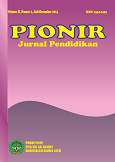ANALYSIS OF LEARNING DIFFICULTIES IN READING COMPREHENSION WITH NEUROLINGUISTIC APPROACH FOR STUDENTS WITH LEARNING DIFFICULTIES IN ELEMENTARY SCHOOL ANUBANWANGMAI SCHOOL THAILAND
DOI:
https://doi.org/10.22373/dnk33535Keywords:
learning difficulties, reading comprehension, neurolinguistic approach, primary schoolAbstract
This study investigates learning difficulties in reading comprehension among primary school students using a neurolinguistic approach. The neurolinguistic approach focuses on the relationship between brain processes and language skills, aiming to align teaching strategies with how the brain processes language. A descriptive qualitative method was employed, with data collection techniques including observation, interviews, and reading comprehension tests. The research subjects consisted of fourth and fifth grade students who faced barriers in reading comprehension. The results indicated that internal factors, such as attention disorders, limited vocabulary, and difficulties in mapping sentence structures, significantly affect reading comprehension. Additionally, external factors, including inadequate teaching methods and a lack of learning media, contribute to these difficulties. The study demonstrates that neurolinguistic strategies, such as visualization, repetition, and concept mapping, can improve students' comprehension by aligning teaching with cognitive processes. The findings suggest that neurolinguistic strategies may be effectively integrated into reading instruction to address comprehension challenges, offering a promising approach for enhancing reading skills in elementary education.
Keywords: Learning difficulties, reading comprehension, neurolinguistic approach, primary school
References
Anderson, R. C., & Freebody, P. (2020). Reading comprehension and vocabulary. Journal of Educational Psychology, 45(3), 245-260.
Anderson, J. R. (2020). Cognitive Neuroscience of Reading Comprehension. International Journal of Educational Research, 88(3), 112-129.
Chen, L., & Wong, M. (2019). "Neurological Approaches to Reading Difficulties: A Comprehensive Review". Educational Neuroscience, 22(4), 201-225.
Gagne, E., & Briggs, L. (2021). Principles of Instructional Design. New York: Holt, Rinehart & Winston.
Lee, J., & Kim, H. (2020). "Faktor Multidimensional dalam Kesulitan Membaca". Journal of Applied Psychology, 55(1), 34-52.
Marzano, R. J. (2019). The Art and Science of Teaching. Bloomington: Solution Tree Press.
Nation, I. S. P. (2018). Learning vocabulary in another language. Cambridge: Cambridge University Press.
Pratama, R. (2018). Strategi Intervensi Kesulitan Belajar Berbasis Neurosains. Bandung: Penerbit Universitas Pendidikan Indonesia.
Rahmawati, D. (2021). "Pendekatan Inovatif dalam Mengatasi Kesulitan Membaca di Sekolah Dasar". Jurnal Pendidikan Nasional, 15(2), 45-67.
Rahmawati, D., & Saputra, H. (2022). "Pendekatan Komprehensif dalam Kesulitan Membaca". Jurnal Pendidikan Inovatif, 18(3), 45-62.
Saputra, H. (2022). Neurolinguistik dan Kesulitan Belajar Membaca. Jakarta: Penerbit Universitas Indonesia.
Vygotsky, L. S. (2020). Mind in society: The development of higher psychological processes. Harvard University Press.
Wong, M., & Liu, S. (2019). "Prevalensi dan Karakteristik Kesulitan Membaca". Educational Research Quarterly, 42(2), 78-95.
Downloads
Published
Issue
Section
License
Copyright (c) 2025 Nur Az Zahra

This work is licensed under a Creative Commons Attribution-ShareAlike 4.0 International License.
- Authors retain copyright and grant the journal right of first publication with the work simultaneously licensed under a Creative Commons Attribution License that allows others to share the work with an acknowledgment of the work's authorship and initial publication in this journal.
- Authors are able to enter into separate, additional contractual arrangements for the non-exclusive distribution of the journal's published version of the work (e.g., post it to an institutional repository or publish it in a book), with an acknowledgment of its initial publication in this journal.
- Authors are permitted and encouraged to post their work online (e.g., in institutional repositories or on their website) prior to and during the submission process, as it can lead to productive exchanges, as well as earlier and greater citation of published work (See The Effect of Open Access).

